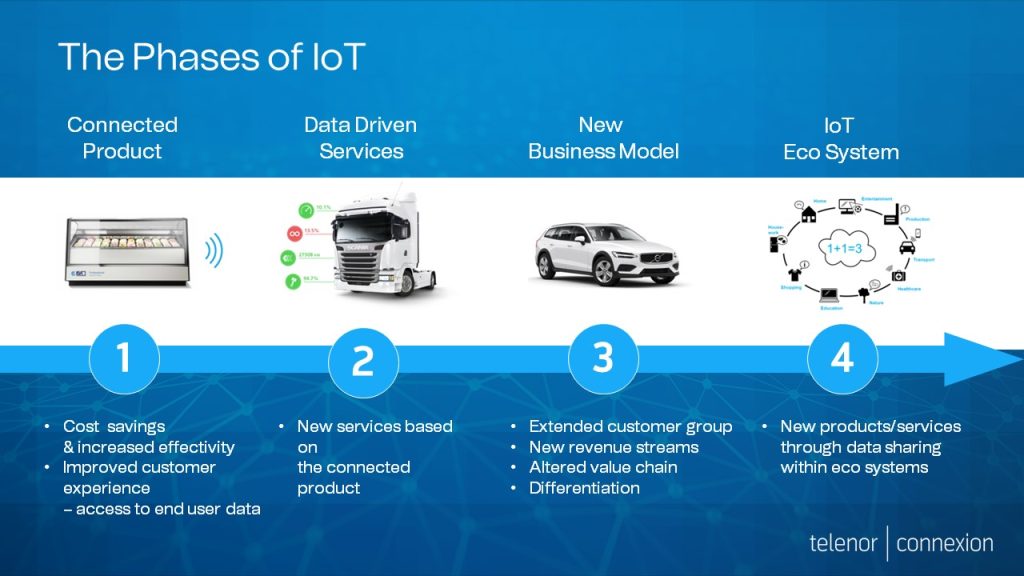Exploring the Definition of IoT and Its Deployment Phases (IoT Tutorial, Chapter 1)
In this chapter, we will define what IoT is and look at the different phases that an organization can go through when adapting its business to IoT. We will also look at some different examples of how IoT can be used to enhance a product. Explore more insights on our IoT tutorial page, featuring the full-length video tutorial.
Watch the Video-Tutorial Now
IoT plays an important part in many organizations’ digitalization journey. Organizations all around the world are constantly exploring how to conduct their business in a more efficient way, to optimize their workforce and bring even more value to their customers.
The Definition of IoT (Internet of Things)
Let’s start by stating a definition, so that we have a common understanding of what IoT is.
There are different definitions out there, at Telenor we define IoT as:
The concept of connecting any device (i.e “thing”) to the internet, or to another device. So that the device can send or receive information or perform a remotely controlled task. This can include any device, sharing any kind of information or performing almost any task you can think of.
An IoT device is quite commonly called a “thing”.
Deployment Phases of IoT Solutions: A Comprehensive Overview
Let’s start by looking at the development phases. This will give you an overview of the steps we generally see when companies are deploying IoT Solutions.

Key Drivers for Connecting Products
It all starts with the connected product and ensuring that it is manufactured with the capability to communicate with another device, or with the manufacturers’ back-end systems.
One main driver for connecting your product can be to lower costs or increase productivity. This can be achieved by a connected product that shares data so that the need to physically visit the equipment to collect information is removed.
It can also be the ability to schedule preventive maintenance based on running hours for each device.
For some products, IoT connectivity is at the core, for instance, a home alarm system or an electric meter.
Several Automotive manufacturers have enhanced their vehicles with IoT to provide an extended service. This can range from automated emergency calls to the ability to remotely control the heater in your car.
As IoT is penetrating more and more industries many companies find that they need to include IoT to stay relevant for their customers.
Global IoT Connectivity
Data-Driven Services with Connected Devices
The connected device allows the company to start introducing data-driven services, where the collected data from each device is used to create value for the end customer.
One example of this is Scania, where fuel consumption statistics combined with the destination provide the logistics company with details on the optimal amount of fuel for each delivery, ensuring that the truck doesn’t carry extra weight if it’s not needed.
Product-to-Service Transformation: A New Business Model
In the third phase, we find companies that have been able to convert their product into a service, adapting to a new Business Model.
So instead of buying a climate system, you buy the service “fresh air” for your office space.
Instead of buying a car you subscribe to a mobility service, giving you access to a car when you need it.
There are many examples of products that are used only a fraction of their lifetime, think of the possibilities to get more out of each product by ensuring it’s used more hours of the day.
From Product to Connected Product-as-a-Service
Optimizing Resources: The Role of IoT Ecosystems
Speaking of optimizing resources, the fourth phase is what we call the IoT Ecosystem, where companies start to share data with each other, to provide the consumers with a seamless experience.
By combining the insights from different products, the result is exponentially better, with benefits both for the consumer and each participating company.
This can range from cars reporting on the weather conditions, so preventive anti-skid measures can be applied where needed, to a water pump speeding up based on the scheduled wash cycle of the machines in a building.
Conclusion
In this chapter, we have defined IoT and looked at the different phases that an organization can go through when adapting their business to IoT. We have also looked at some different examples of how IoT can be used to enhance a product.
IoT is a powerful tool that can be used to improve efficiency, optimize resources, and bring even more value to customers.

